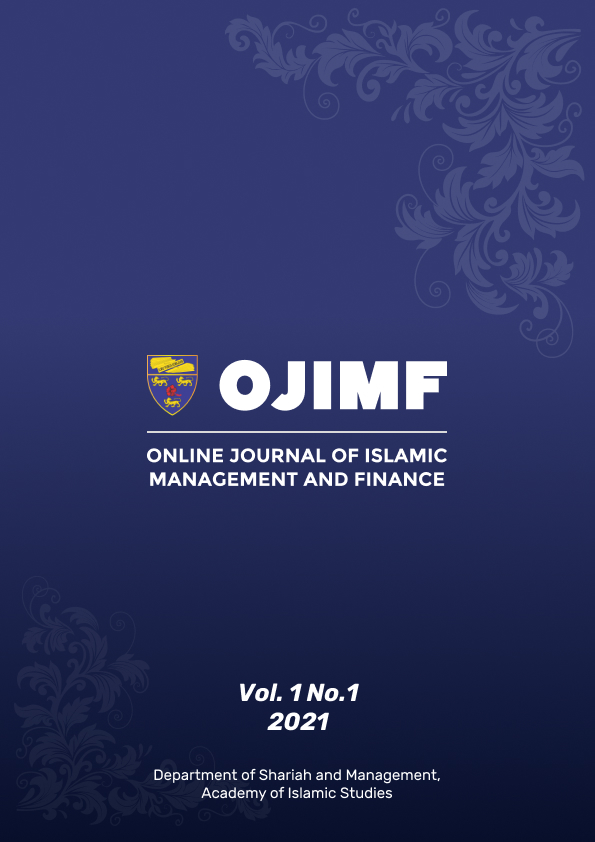PEDAGOGI BERASASKAN PENDEKATAN INDUKTIF DAN DEDUKTIF: PRAKTIS DALAM PENDIDIKAN KEWANGAN ISLAM PEDAGOGY BASED ON INDUCTIVE AND DEDUCTIVE APROACHES: PRACTICE IN ISLAMIC FINANCE EDUCATION
Main Article Content
Abstract
The aim of this article is to study the inductive and deductive approaches, and to analyze their practices in teachers teaching in the context of Islamic finance areas. These approaches are explained in detail based on theoretical aspects and how they can be implemented in teaching and learning process among the teachers in higher education by giving some examples of Islamic finance as a case study. This study shows the relationship between the identification of these approaches in teaching and learning with the usage of the approaches efficiently, thus it will influence to the maximum course learning outcomes. Hence, identification of the approaches in teaching and learning is vital due to the role of teachers is not only seen as transferring knowledge and skills to the students but also ensuring the students show understanding and practice the teaching inputs. Therefore, the identification of the right approach will ease the process of usage the approach effectively towards achieving the learning outcomes as required. In conclusion, the identification and the practice of teaching approach accurately will make sure the teaching and learning process are conducted relevantly and appropriately to the stated educational objectives and the course learning outcomes.
Downloads
Article Details
References
Ab Halim, T., Kamarul Azmi, J. & Muhamad Faiz, I. (2012). Komponen Asas Untuk Latihan Guru Pendidikan Islam, GJAT, Vol. 2(2), h. 53-63.
Ab Mumin, A. G. (1999). Sistem Kewangan Islam dan Perlaksanaannya di Malaysia. Kuala Lumpur: JAKIM.
Ab. Mumin, A. G. & Fadillah, M. (2006). Struktur Sistem Kewangan Islam di Malaysia dalam Ab. Mumin, A. G. & Fadillah, M. (Eds), Dinamisme Kewangan Islam di Malaysia. Kuala Lumpur: Penerbit Universiti Malaya.
Ahmad, M. S. (2004). Pendidikan Islam:Falsafah, Sejarah dan Kaedah Pengajaran Pembelajaran . Selangor: Fajar Bakti.
Ahmad Sufyan, C. A. (2006). Beberapa Prnsip Ijtihad dalam transaksi Kewangan Islam Semasa: Antara Fleksibiliti dengan Kekangan, dalam Ab. Mumin, A. G. & Fadillah, M. (Eds), Dinamisme Kewangan Islam di Malaysia. Kuala Lumpur: Penerbit Universiti Malaya.
Dewan Bahasa dan Pustaka (2000). Kamus Dewan. Ed. 3, Kuala Lumpur: Dewan Bahasa dan Pustaka.
Dwight H. Perkins, Steven Radelet, David L.Lindauer & Steven A. Block (2001). Economic of Development, ed. ke-5, New York: Norton & Company Inc.
Edward M. A. & Jack C. R. (1974). “Reading, Insights and Approaches,†papers from the RELC Seminar on Recent Developments and Research in Reading Relevant to the Teaching and Learning of English in Southeast Asia, Singapore, July 23-27.
Eggen, P., & Kauchak, D. (2001). Educational psychology: Windows on classrooms (5th ed.). Upper Saddle River, NJ: Prentice Hall.
Fadillah, M., M. Ishaq, B., Shafiqur, R. dan Hung, Q. D. (2020), The Investment Performance of Ethical Equity Funds in Malaysia. Journal of Risk and Financial Management, 13 (9), h. 1-14.
Fadillah, M. (2004). Produk Kad Kredit Islam dan Aplikasinya di Bank Islam Malaysia Berhad (BIMB), Jurnal Syariah, 12(1), h. 114-115.
Kierzek, J.M. (1954). The Macmillan Handbook of English. New York: Macmillan.
Kamarudin, Hj. H. (1993). Perkaedahan Mengajar Bahasa. Kuala Lumpur: Kumpulan Budiman.
Kamarul Azmi, J. & Ab. Halim, T. (2012). Pendidikan Islam, Kaedah Pengajaran dan Pembelajaran. Skudai: Penerbit UTM.
Mook, S. S. (2001). Psikologi Pendidikan untuk Diploma Perguruan Semester 1. Selangor: Kumpulan Budiman Sdn Bhd.
Mohd Azmi, O., Muhamad Abduh, and Raditya, S. 2013. Fundamentals of Islamic Money and Capital Markets. Hoboken: John Wiley and Sons.
Muhaili. (2019). Pembelajaran Inovatif Abad Ke-21. Jurnal Penelitian dan Pengkajian Ilmu Pendidikan: E-Saintika, 3(2), h. 25-50.
Muhammad Ayub (2007). Understanding Islamic Finance, England: John Wiley & Sons Ltd.
Obiyathulla Ismath, B. & Abbas, M. (2013). Islamic Capital Markets, A Comparative Approach. Singapore: John Wiley & Sons.
Othman, Y. (1993). Pasaran Dan Institusi Kewangan Di Malaysia: Teori dan Amalan. Kuala Lumpur: Dewan Bahasa dan Pustaka.
Seaton, B. (1982). A Handbook of English Language Teaching Terms and Practice. London: Macmillan Press.
Suhailiza, M. H., Dini Farhana, B., Nur Kareelawati, A. K. & Eizan Azira, M. S. (2018). Menerokai Model Pendidikan Seimbang Mendepani Abad Ke 21. E-Proceeding International Seminar on Islamiyyat Studies 2018, 1(2), h. 24-32.
Syarifah Alawiyah, Al-S. (1992). Ilmu Pendidikan Pedagogi. Kuala Lumpur: Longman.
Tengku Sarina Aini, T. K. (2014). Transformasi Pendidikan di Malaysia: Implikasi terhadap pendekatan pengajaran dan pembelajaran Pendidikan Islam. Dalam Muhd Lukman, I. et al. (Eds.), Pendidikan Islam di Malaysia: Cabaran dan Penyelesaian. Kuala Lumpur: Program Pendidikan Islam, Akademi Pengajian Islam, Universiti Malaya.
Thornbury, S (1999). How to Teach Grammar. Harlow: Longman.

